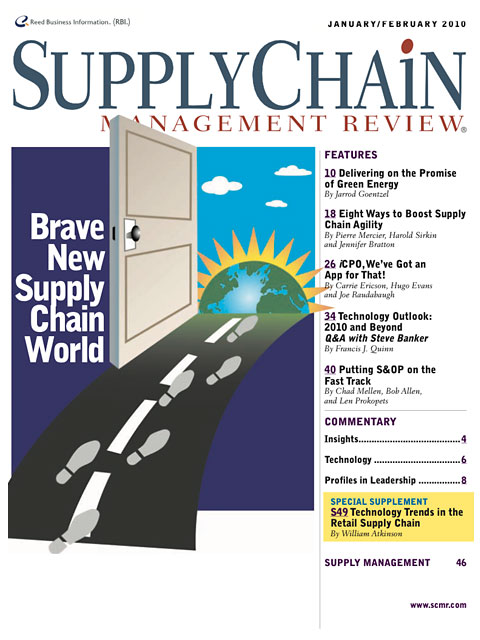Sorry, but your login has failed. Please recheck your login information and resubmit. If your subscription has expired, renew here.
January-February 2010
As the search for news forms of energy intensifies, supply chain professionals are presented with an unprecedented challenge and opportunity: To apply their managerial and analytical skills in delivering this energy to the end consumers. How effectively they respond may ultimately determine whether—and when—the promise of green energy finally gets fulfilled. Browse this issue archive.Need Help? Contact customer service 847-559-7581 More options
As the recent global recession deepened, some industries saw sales decline by 40 percent or more. Cash-strapped companies struggled with order cancellations, inventory pile-ups, and underused assets. The business headlines showed that many organizations were unable to survive those pressures.
Yet many have survived, and are on course to do well as the global economy picks up. The survivors were almost always better able to change course more quickly that their more sluggish peers, minimize losses, and generate much-needed cash. On the whole, they benefitted from more responsive, more agile supply chains, allowing them to quickly cut back on manufacturing shifts, change batch sizes, stop an start entire productions lines, close plants, sell assets, and sharply reduce inventory coming through the pipeline.
Although global recessions are rare, uncertainty and unpredictability are facts of life in today’s business environment. Nobody can truly predict the future, no matter how complex or accurate a company’s forecasting model is. And as supply chains become longer—reaching into low-cost countries for sourcing or manufacturing—it becomes increasingly clear that greater flexibility and the ability to reach to rapidly to changing market conditions are at least as important as forecasting skills when it comes to optimizing end-to-end operations.
These days, the prices of fuel and other commodities can shift overnight, customers demand increasing speed and customization, and port and road congestion add unwelcome variables to the supply chain. Other variability is self-inflicted—the result of needless complexity in products, portfolios, and processes. This blend of complexity and unpredictability exacts a high cost. That’s why it’s critical for companies to create an agile, flexible, supply chain that can react quickly to changes in conditions or demand and minimize the negative impact of uncertainty.
 |
This complete article is available to subscribers
only. Click on Log In Now at the top of this article for full access. Or, Start your PLUS+ subscription for instant access. |
SC
MR
Sorry, but your login has failed. Please recheck your login information and resubmit. If your subscription has expired, renew here.
January-February 2010
As the search for news forms of energy intensifies, supply chain professionals are presented with an unprecedented challenge and opportunity: To apply their managerial and analytical skills in delivering this energy… Browse this issue archive. Download a PDF file of the January-February 2010 issue.
 |
Download Article PDF |
As the recent global recession deepened, some industries saw sales decline by 40 percent or more. Cash-strapped companies struggled with order cancellations, inventory pile-ups, and underused assets. The business headlines showed that many organizations were unable to survive those pressures.
Yet many have survived, and are on course to do well as the global economy picks up. The survivors were almost always better able to change course more quickly that their more sluggish peers, minimize losses, and generate much-needed cash. On the whole, they benefitted from more responsive, more agile supply chains, allowing them to quickly cut back on manufacturing shifts, change batch sizes, stop an start entire productions lines, close plants, sell assets, and sharply reduce inventory coming through the pipeline.
Although global recessions are rare, uncertainty and unpredictability are facts of life in today’s business environment. Nobody can truly predict the future, no matter how complex or accurate a company’s forecasting model is. And as supply chains become longer—reaching into low-cost countries for sourcing or manufacturing—it becomes increasingly clear that greater flexibility and the ability to reach to rapidly to changing market conditions are at least as important as forecasting skills when it comes to optimizing end-to-end operations.
These days, the prices of fuel and other commodities can shift overnight, customers demand increasing speed and customization, and port and road congestion add unwelcome variables to the supply chain. Other variability is self-inflicted—the result of needless complexity in products, portfolios, and processes. This blend of complexity and unpredictability exacts a high cost. That’s why it’s critical for companies to create an agile, flexible, supply chain that can react quickly to changes in conditions or demand and minimize the negative impact of uncertainty.
 |
SUBSCRIBERS: Click here to download PDF of the full article. |
SC
MR

Latest Supply Chain News
- How CPG brands can deliver on supplier diversity promises
- How S&OP provides the answer to in-demand products
- AI, virtual reality is bringing experiential learning into the modern age
- Humanoid robots’ place in an intralogistics smart robot strategy
- Tips for CIOs to overcome technology talent acquisition troubles
- More News
Latest Podcast

 Explore
Explore
Latest Supply Chain News
- How CPG brands can deliver on supplier diversity promises
- How S&OP provides the answer to in-demand products
- AI, virtual reality is bringing experiential learning into the modern age
- Humanoid robots’ place in an intralogistics smart robot strategy
- Tips for CIOs to overcome technology talent acquisition troubles
- There is still work to do to achieve supply chain stability
- More latest news
Latest Resources

Subscribe

Supply Chain Management Review delivers the best industry content.

Editors’ Picks





